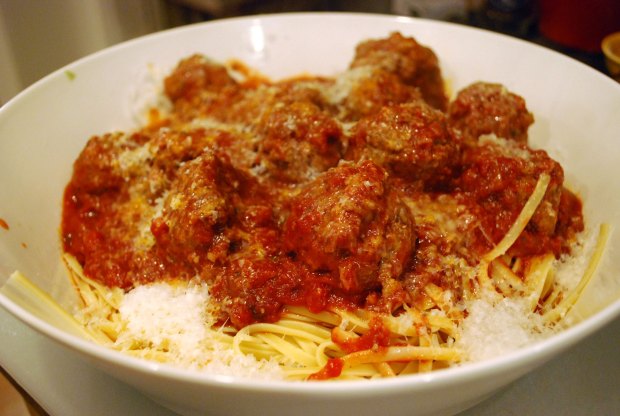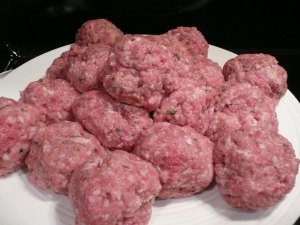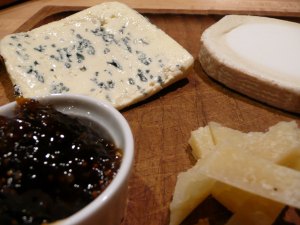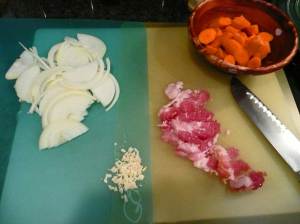
Some recipes, like croissants, are expected to be difficult and involved. Recipes like those take actual scheduling to tackle – as in, when will I have three straight days in the same kitchen without interruption? Other recipes such as, um, spaghetti and meatballs, seem so simple as to be almost an afterthought. In fact, even though I knew that I needed to post this recipe today along with the other Barefoot Bloggers, I figured it would only take a half hour or so to make and photograph, so it was only last night that I began it.
While spaghetti and meatballs is one of those American classics, it was never something my mother made. If she had, maybe I would know that this dish takes FOREVER… At least the way Ina makes it. The meatball combining and forming is not time-consuming, but frying said meatballs (in batches, no less) takes a long while… Those puppies cook slow over medium-low heat. Then you make the sauce and cook the meatballs in the sauce for a half hour. The only thing you can do simultaneously – since Ina insists you use the meatball-browning pan for the sauce – is boil the pasta.
All that being said, the meatballs tasted great. They had a light texture and a subtle but interesting flavor, led by the addition of nutmeg. RJ immediately said “Great Meatballs!” – not eloquent or revelatory necessarily, but still sincere and based in experiential expertise. Not sure I’d take the hour+ on another weeknight to make this dish, however.
Spaghetti and Meatballs, from Barefoot Contessa Family Style
(Serves 6)
For the meatballs:
1/2 lb. ground veal
1/2 lb. ground pork
1 lb. ground beef
1 c. fresh white bread crumbs (4 slices, crusts removed)
1/4 c. seasoned dry bread crumbs
2 Tbs. chopped fresh flat-leaf parsley
1/2 c. freshly grated Parmesan cheese
2 tsp. kosher salt
1/2 tsp. freshly ground black pepper
1/4 tsp. ground nutmeg
1 extra-large egg, beaten
Vegetable oil
Olive oil
For the sauce:
1 Tbs. good olive oil
1 c. chopped yellow onion (1 onion)
1 1/2 tsp. minced garlic
1/2 c. good red wine, such as Chianti
1 (28-ounce) c. crushed tomatoes, or plum tomatoes in puree, chopped
1 Tbs. chopped fresh flat-leaf parsley
1 1/2 tsp. kosher salt
1/2 tsp. freshly ground black pepper
1 1/2 lbs. spaghetti, cooked according to package directions
Freshly grated Parmesan
 Place the ground meats, both bread crumbs, parsley, Parmesan, salt, pepper, nutmeg, egg, and 3/4 cup warm water in a bowl. Combine very lightly with a fork. Using your hands, lightly form the mixture into 2-inch meatballs. You will have 14 to 16 meatballs.
Place the ground meats, both bread crumbs, parsley, Parmesan, salt, pepper, nutmeg, egg, and 3/4 cup warm water in a bowl. Combine very lightly with a fork. Using your hands, lightly form the mixture into 2-inch meatballs. You will have 14 to 16 meatballs.
Pour equal amounts of vegetable oil and olive oil into a large (12-inch) skillet to a depth of 1/4-inch. Heat the oil. Very carefully, in batches, place the meatballs in the oil and brown them well on all sides over medium-low heat, turning carefully with a spatula or a fork. This should take about 10 minutes for each batch. Don’t crowd the meatballs. Remove the meatballs to a plate covered with paper towels. Discard the oil but don’t clean the pan.

For the sauce, heat the olive oil in the same pan. Add the onion and saute over medium heat until translucent, 5 to 10 minutes. Add the garlic and cook for 1 more minute. Add the wine and cook on high heat, scraping up all the brown bits in the pan, until almost all the liquid evaporates, about 3 minutes. Stir in the tomatoes, parsley, salt, and pepper.
Return the meatballs to the sauce, cover, and simmer on the lowest heat for 25 to 30 minutes, until the meatballs are cooked through. Serve hot on cooked spaghetti and pass the grated Parmesan.


 2. When serving cheese as a course during dinner, it is best to limit yourself to one to three cheeses, as more can overwhelm the palate. In this setting, it is particularly nice to offer a variety – different milks (cow, sheep, and goat), different textures (soft, semi-hard, hard), maybe one blue cheese – and possibly a selection of accompaniments (baguette and walnut bread or crackers; a fig jam or chutney; some honey and walnuts; or a side plate with olives, cured meats, and fresh fruit).
2. When serving cheese as a course during dinner, it is best to limit yourself to one to three cheeses, as more can overwhelm the palate. In this setting, it is particularly nice to offer a variety – different milks (cow, sheep, and goat), different textures (soft, semi-hard, hard), maybe one blue cheese – and possibly a selection of accompaniments (baguette and walnut bread or crackers; a fig jam or chutney; some honey and walnuts; or a side plate with olives, cured meats, and fresh fruit).  St. Agur
St. Agur

 Heat the olive oil in a large Dutch oven. Add the bacon and cook over medium heat for 8 to 10 minutes, until lightly browned. Remove the bacon to a plate with a slotted spoon.
Heat the olive oil in a large Dutch oven. Add the bacon and cook over medium heat for 8 to 10 minutes, until lightly browned. Remove the bacon to a plate with a slotted spoon. Mash 1 tablespoon of butter and the flour together and stir into the stew. Add the frozen onions. In a medium saute pan, add the remaining 1 tablespoon of butter and cook the mushrooms over medium-low heat for 5 to 10 minutes, until browned. Add to the stew. Bring the stew to a simmer and cook for another 10 minutes. Season to taste. Serve hot.
Mash 1 tablespoon of butter and the flour together and stir into the stew. Add the frozen onions. In a medium saute pan, add the remaining 1 tablespoon of butter and cook the mushrooms over medium-low heat for 5 to 10 minutes, until browned. Add to the stew. Bring the stew to a simmer and cook for another 10 minutes. Season to taste. Serve hot.


